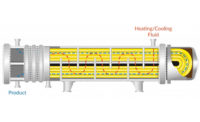Automation is increasingly becoming the answer for greater efficiencies and efficacy in dairy warehouse operations. Processors are enhancing supply chain and logistics functions and other warehousing responsibilities with technologies intended to streamline worker expenses while enhancing productivity.
“Most materials-handling automation suppliers recognize the dairy processing industry as a leader in adapting new technologies,” says Charles Fallon, president of LIDD, a Montreal-based supply-chain consulting firm. “Dairy processing involves high volumes of short-shelf-life product, and processors seek all opportunities to reduce their operating costs. Therefore, suppliers make efforts to adapt their solutions to the dairy processing context.”
He notes that technologies are increasing efficiencies by displacing workers from functions that can be readily automated, and “for the balance of labor functions, the technologies can increase the handling rate of individual workers by directing them in the most efficient manner possible.”
Automating dairy warehouse operations also is important because of labor shortages and rising personnel costs, says Joe Del Greco, vice president of supply chain solutions for Tippmann Group/Interstate Warehousing, a Fort Wayne, Ind.-based provider of refrigerated warehouse space and a designer/builder of temperature-controlled food plant and cold storage warehouse facilities.
“Labor is hard to find and terribly expensive,” he says, noting that replacing labor with automation will also result in fewer mistakes.
Processors should study the return on investment (ROI) when making technology investment decisions, Del Greco says, which will help them decide, for instance, if they should earmark capital for equipment purchases or use third-party service providers.
“There is no right or wrong as one size does not fit all,” he says.
Indeed, processors might find the ROI is more favorable when replacing 50 workers with technologies than it would be for a smaller 10-person operation, Del Greco says. Yet a switch to automation also could result in less operational flexibility, he notes.
“Retailers want products with the longest shelf life and therefore want to order ‘just in time,’” Del Greco says. “This creates smaller and more frequent orders, which requires much case-picking and more labor than in the past.”
In addition to labor productivity gains, the technologies can allow dairy processors to increase storage density, Fallon says, “which means less warehousing footprint and lower facility costs.”
The systems also can improve product quality by efficiently managing and maintaining product rotation, which can eliminate shipment codes that are out of date, Fallon says.
“They provide a robust tracing capability that, over time, means dairy processors are building a safer, higher quality supply chain,” he says.
A bevy of benefits
The technologies can further enhance dairy operations by ensuring higher and more reliable throughput, says Mike Stein, vice president of marketing and product management, automation and packaging technologies platform for Signode Industrial Group LLC. The Glenview, Ill.-based company provides transit packaging consumables, tools, software and equipment.
He notes that automation from an equipment and warehouse-management control perspective is going to become increasingly important.
“The more automated your operation, if designed, deployed and maintained properly, the more control you have over labor costs, spoilage costs, material-handling costs and the costs associated with maintaining temperature control in large facilities,” Stein says. “Automation is able to raise performance and lower costs concurrently.”
Software improvements, meanwhile, are enabling processors to have greater visibility into their operations, including real-time monitoring of such elements as lighting, door operations, refrigeration and temperature controls, says Collin Coker, vice president of sales and marketing for Viking Cold Solutions Inc., a a Houston-based provider of sustainable refrigeration optimization technology. He notes that predictive capabilities are enabling operators to identify and prevent potential technology glitches — for example, allowing them to replace machine parts before failures occur.
The optimal warehouse technologies will differ in accordance with the size and scope of a processor’s operation, Coker says. A small mom and pop or regional processor, for instance, that lacks the capital to invest in a large warehouse management system might prefer the services of a third-party provider, he notes.
Technologies, meanwhile, are becoming more efficient with better integration functionality, Del Greco says, which enables, for instance, the effective managing of pallet movements within a facility. He notes that all warehousing technologies will center around traceability, transparency and managing labor.
“It is important to be transparent throughout the entire supply chain, and much of that is dictated by the warehouse management system,” he says. “You need to have visibility of products for recall purposes if necessary.”
Meanwhile, automated storage and retrieval systems (AS/RS), which are intended to support the buffering, storing and retrieval of product and inventory on demand, are becoming increasingly prevalent and are effectively reducing and preventing recalls, says John Hinchey, vice president of sales for Westfalia Technologies Inc. The York, Pa.-based company provides warehouse automation systems.
He notes that an AS/RS increases the speed that products move in and out of warehouses, preventing spoilage. And automated dairy warehousing can reduce costs, increase inventory accuracies, boost productivity and optimize material flow.
In addition, the use of electronic data interchange (EDI), the computer-to-computer exchange of business documents in a standard electronic format between business partners, is becoming a more frequent, affordable and faster way to support supply chain and logistics operations, analysts say. Unlike e-mail, EDI does not require employee handling of documents, which can slow processing and introduce errors.
While invoices, purchases orders and advanced shipping notices are the most common EDI documents, operators also send routing instructions, inventory inquires and product activity reports as part of the advanced planning for supply chains, says Joseph Klingseisen, president of Applied Net Solutions LLC, a Delafield, Wis.-based sales management, consulting and project management company representing software developers.
He notes that EDI documents are “accepted by the food chain community all over the world” and are enabling dairy processors to improve document accuracy. They also are allowing processors to eliminate manual data entry expenses and enable real-time visibility into transaction status, “promoting quicker decision-making and enhanced responsiveness to customer demands.”
Klingseisen adds that “virtually all major trading partners and thousands of others,” including the largest dairy retailers, require their business partners to be EDI compliant.
Prepare for the difficulties
A major processor challenge, however, is ensuring that an automation system can integrate materials from different developers, Stein says — for example, “equipment from vendor A, with a cart system from vendor B, with a track-and-trace system from vendor C.” He notes that as standalone solutions, “they work quite well,” but not necessarily well together.
“Everything about running the distribution of dairy is a challenge,” Hinchey adds. “Expiration dates are short; the regulatory environment is strict; and quality assurance is a must.”
Unlike some other industries where processors must adjust to different consumer needs and plan for quarterly fluctuations in demand, dairy operators might have to modify shifts each month or week, he says.
“Worse, because the products you sell are related to the health and wellbeing of the consumer, a recall receives much higher scrutiny from media organizations, regulatory bodies, and the consumers themselves,” Hinchey states.
Effectively handling such issues requires timely decision-making, visibility, control and collaboration, he says.
To operate most efficiently, processors need to first define their key objectives, pinpoint the biggest challenges and hurdles, and determine the type of integrated approach between equipment and asset management that would deliver the best ROI and results, Stein says.
“Then find a partner who can customize an end-to-end solution that will meet those needs,” he states.
Having suppliers that can design and provide ongoing maintenance for the various technology components is important as well, Hinchey says, adding that the vendors should be active in every project stage, including planning, design, manufacturing, installation, testing, training, commissioning and maintenance/service.
“Choosing a vendor that understands your specific needs is the only way to guarantee that the total solution matches your economic, technical and organizational requirements,” he says.
Operators can help streamline the learning curve for technology implementation by having user-friendly and intuitive equipment and interfaces, while seeing that users undergo proper training, says Erik Grinnell, vice president of automation for Quest Industrial LLC. The Monroe, Wis.-based manufacturer of industrial automation equipment focuses on robotics and vision-guidance for dairy and other food and beverage industries.
He notes that dairy producers should “invite an expert” who can advise on the available technologies, adding that a good starting point for automation is any process that requires physical labor and involves dangerous environments, tasks or repetitive motion. Grinnell adds that it is important for a processor to choose a solution provider that understands the dairy process, “as it will minimize the learning curve for both maintenance and operators.”
Take it slow
It is paramount, however, that processors do not make hasty decisions when selecting their warehousing technologies, Fallon says.
“While the opportunities for cost reductions are significant, the risks of deploying capital on failed projects are significant as well,” he says. “A thorough engineering study should proceed any investment.”
Such a study could require spending 1% to 2% of the total technology investment upfront to ensure that a proposed solution works within the unique context of the processor, Fallon says. Variables can include an operator’s unit-handling volumes, a facility’s layout and the processor’s IT infrastructure, he says, adding that most failed projects result from a lack of attention to IT and that operators should focus on IT from the start.
“If the IT work finishes four months early, then you have won the opportunity to test, test and test. It will make go-live vastly more successful,” he says.
Warehousing technologies, meanwhile, are covering a wider range of operations. That includes the use of self-driving vehicles that can handle wet, cold and washdown environments while preventing forklift truck drivers from contacting product, Grinnell says. Along with robotics, the automation helps “eliminate the need for much of the back-breaking labor and frees up operators to focus on the production quality,” he says. “In dairy, timing is everything, so the faster a product can be produced and moved, the faster new product can be produced.”
Coker adds that having the ability to easily push a button and receive activity reports that reveal the state of operations (such as the need to add more trucks to the transportation system) is valuable.
“Being easily able to decide what I have the capacity to do helps me make better business decisions, and that comes down to visibility,” he says.







